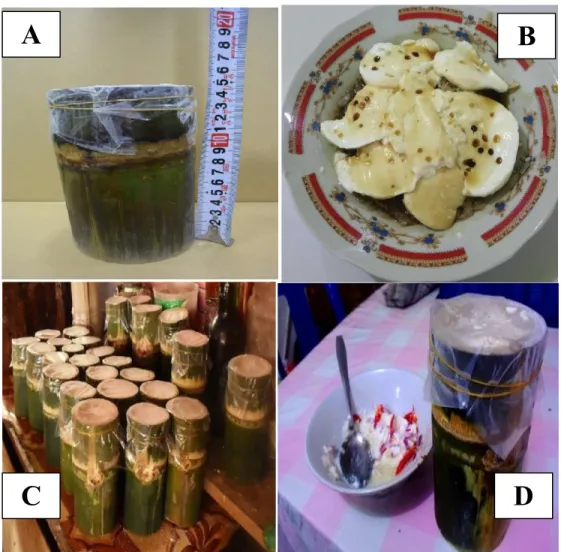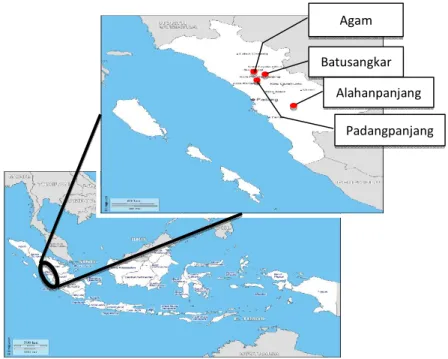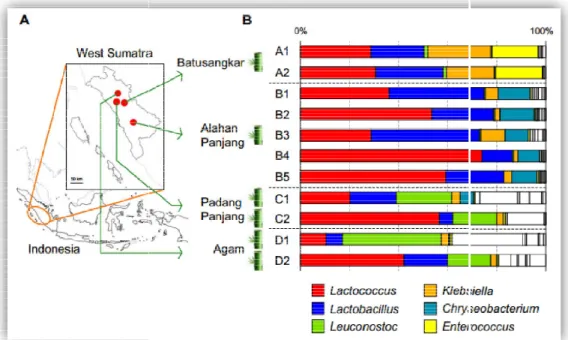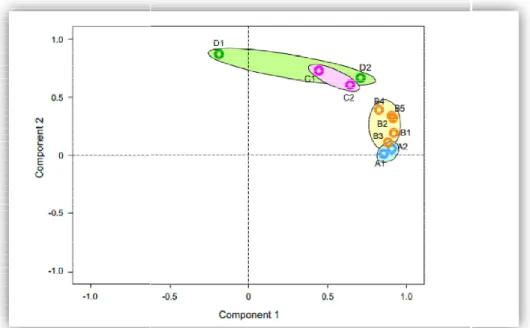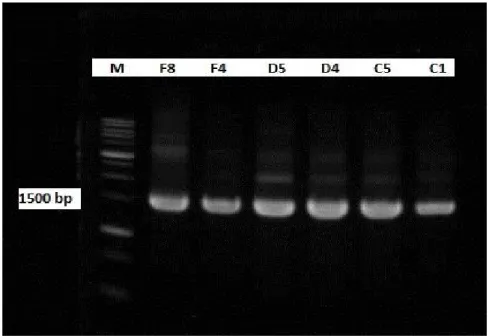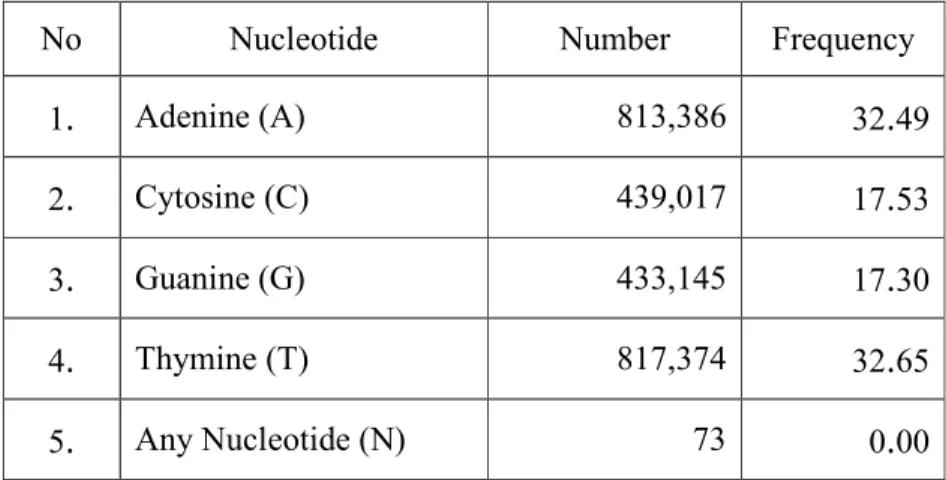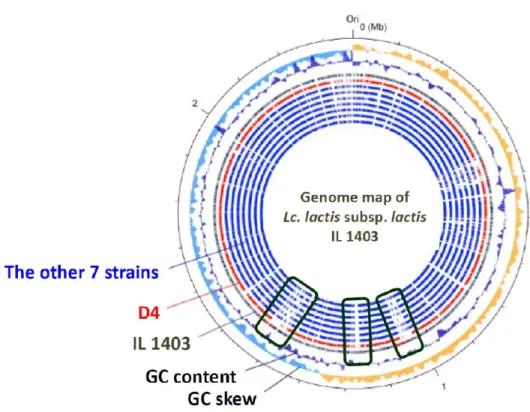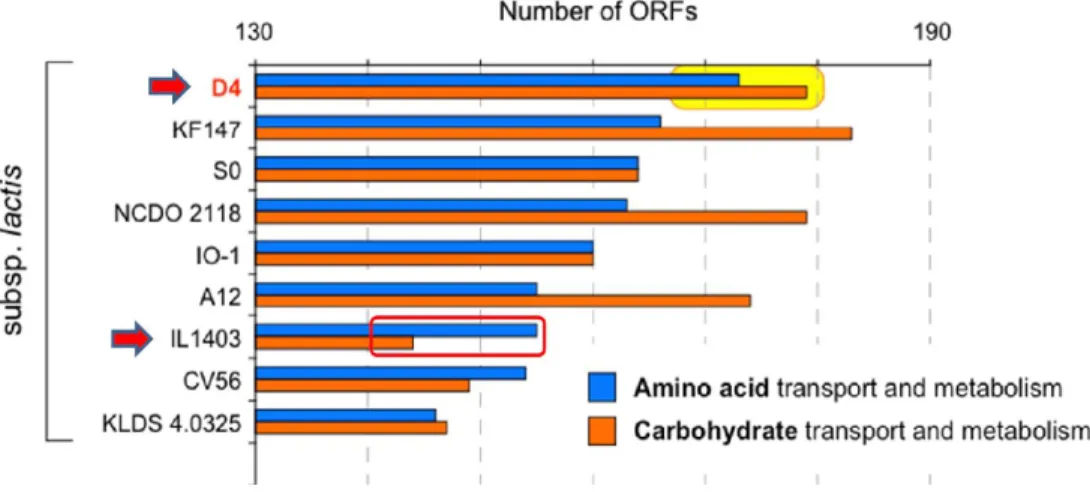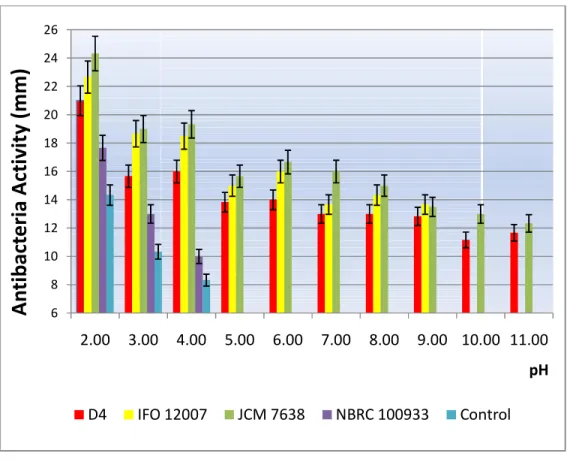1
Analysis of Microbiota in, and Isolation of Nisin-Producing Lactococcus lactis subsp .
lactis Strains from, Indonesian Traditional Fermented Milk, Dadiah
2017, September
SUKMA Ade
Graduate School of
Environmental and Life Science (Doctor’s Course)
OKAYAMA UNIVERSITY
2
Contents.
Contents. ... 2
List of Figures ... 5
List of Tables ... 7
I. GENERAL INTRODUCTION ... 8
II. Analysis of Microbiota Community Structure in Traditional Fermented Milk Dadiah ... 20
ABSTRACT ... 20
1
.
INTRODUCTION ... 212
.
MATERIALS AND METHODS ... 21A
.
Dadiah samples, purification of bacterial genome DNA the samples and amplification of 16S ribosomal RNA gene from bacterial genome DNA ... 21B
.
Deep sequencing and data analysis.
... 233
.
RESULTS ... 244
.
DISCUSSION ... 275
.
CONCLUSIONS ... 293
III. Isolation Nisin-Producing Lactococcus lactis subsp. lactis
Isolated from Dadiah ... 31
ABSTRACT ... 31
1
.
INTRODUCTION ... 322
.
MATERIALS AND METHODS ... 33A
.
Bacterial strains and growth media ... 33B
.
Antimicrobial activity assay ... 34C
.
Genome DNA purification for sequencing ... 35D
.
Effect of pH, heat treatment and enzymes treatments ... 36E
.
Antibacterial wide spectrum assay ... 37F
.
Confirmation Nisin-Producing Strain ... 38G
.
SDS-PAGE and in-situ activity assay ... 393
.
RESULTS ... 39A
.
Isolation and identification of bacteriocin-producing strain ... 39B
.
Identification of the isolated strain and its draft genome sequence ... 40C
.
Effect of pH to antibacterial bacteriocin ... 45D
.
Effect of heat treatment on antibacterial activity ... 474
E
.
Effect of enzyme treatment ... 48F
.
Antibacterial spectrum assay ... 49G
.
Nisin production confirmation ... 52H
.
Estimation of peptide molecular weight ... 544
.
DISCUSSION ... 555
.
CONCLUSIONS ... 60IV. SUMMARY ... 62
V. ACKNOWLEDGMENTS ... 65
VI. REFERENCES ... 67
5
List of Figures
Figure 1: A. Original dadiah
B. Dadiah on display at traditional market C. Sambal dadiah
D. Ampiang dadiah ... 10 Figure 2: Bacteriocin classifications (Klaenhammer, 1993; Chen and
Hoover, 2003; Jeevaratnam, Jamuna and Bawa, 2005;
Karpiński and Szkaradkiewicz, 2013; Kaur, 2015). ... 13 Figure 3: Timeline of nisin development (Shin et al., 2016) ... 18 Figure 4: Sample area taken West Sumatera Province of Indonesia. ... 22 Figure 5: A. Sample area taken in West-Sumatera Indonesia.
B. Microbiome distribution genes on various dadiah producer areas. ... 25 Figure 6: Microbiota community closeness variety on each area has
described on PCA chart. ... 26 Figure 7 : DNA sequence of approximately 1.400 bp for 16S rRNA
gene using Primer 27F and 1525R ... 41 Figure 8: Six isolate colonies fingerprinting rep-PCR along with three
control strains ... 42
6 Figure 9: Mapping of Lc. lactis subsp. lactis strain D4 draft genome
sequence to Lc. lactis subsp. lactis strain IL1403 complete genome. On the outside circle is genome size in base-pair.
D4 strain mapping shown in red. The green box showed the difference between strain IL1403 and other strains. ... 44 Figure 10: Number of gene encoded function (amino acid and
carbohydrate metabolism) by each genomic sequence. ... 45 Figure 11: Effect of pH to antibacterial bacteriocin. ... 46 Figure 12: Effect of various temperatures to bacteriocin antibacterial
activity. ... 47 Figure 13: Effect of various enzymes to bacteriocin antibacterial
activity. ... 49 Figure 14: A. Agarose gel electrophoresis of PCR product within
nisin-specific gene primer, with marker 100–3000 bp.
B. The nucleotide sequence of nisin Z isolated from D4 by using nisin- specific primer. At this sequence has shown exchanging histidine (CAT) on Nisin A to Asparagines (AAT) as nisin Z specific. ... 53 Figure 15: SDS-PAGE In situ assay analysis purification of nisin and
commercial nisin. Inhibitory zone cell-free-supernatant appears around molecular weight 3.5 kDa of Lc. lactis D4 and commercial nisin. Listeria monocytogenes VTU 206 was used as indicator strain ... 55
7
List of Tables
Table 1: Differences Bacteriocin and Antibiotic (Perez, Zendo and Sonomoto, 2014)... 15
Table 2: Nucleotide distribution (G+C content = 34
.
83 %) ... 43Table 3: Genome features of the draft genome sequence of strain D4 and eight complete genome sequence of Lc
.
lactis subsp.
lactis various sources ... 43 Table 4: Antimicrobial spectrum assay cell-free supernatant (CFS) of
tested strains ... 50
8
I. GENERAL INTRODUCTION
Dadiah is one of indigenous Minangese food that found in West- Sumatera Indonesia
.
This dadiah is made by fermented buffalo milk incubating on bamboo and covered with bananas leaf for two days at room temperature.
Dadiah has found in West-Sumatra, Indonesia.
In the past, dadiah was considered as luxurious food.
It must be served when culture festival was conducted such as wedding party and important ceremonial.
Unfortunately, most of the youth even from Minangese itself has started to abandoned dadiah existence.
The dadiah was a symbol of Minangese identity.
One of this research aims to return dadiah at deserve where it belongs.
There are four sub-provinces which still production, even the productions itself do not continuously
.
Several barriers like fluctuate lactating period, harvesting time and milking production are some of the reasons of un- continuously manufacture.
The four sub-province areas are Batusangkar, Padangpanjang, Agam and Alahanpanjang.
Every district has dadiah speciality and characteristic.
Besides minor microbes, each dadiah also has different composition nutrient ingredients.
It is because every district has a different environment, temperature and producer habit.
The purposes of this study are:analysing microbiota community structure of dadiah, investigating identification and purification of potential Bacteriocins-producer on lactic acid bacteria
9 produced by strains from dadiah
.
There is no bacteriocin detection on dadiah recorded so far.
Usually, dadiah has enjoyed during breakfast as rice-dressing mixed with chopping chilli, dice onion and shallot, this meal locally said as Sambal (Figure
.
1C)
.
Another way to enjoyed dadiah is blending with steamed glutinous rice flake then mixed with liquid palm sugar as a toping product called as Ampiang dadiah (Surono, 2015) (Figure 1D).
Nowadays, various ways have developed in order to re-socialize dadiah to society.
Today, people can enjoy dadiah on traditional ice cream form.
dadiah was blending with sugar and some artificial flavour to manipulate sour tasted before freeze on -20 °C.
Affected with Middle East recipe, some places also use dadiah as main spicy to make mutton curry as replace yoghurt on it.
Dadiah is semi solid form product typically tofu-like consistency has face natural fermentation without pre-heating interface
.
Dadiah fermentation process on bamboo tube has tendency anaerobe facultative cause of covered well by banana leaf.
This stage led to increasing viscosity to buffalo milk turning coagulating then semi solid.
Sour tasted on dadiah caused by organic acid (lactic acid) as result of lactose fermenting, and specific flavour cause of combination between bamboo powder that found on bamboo and fermented buffalo milk volatile compound.
Comparing with famous yoghurt, dadiah has thicker textures caused separation between curd and whey on milk.
On dadiah, whey has absorbed10 by bamboo rather than mixed back with curd
.
That’s the reason dadiah has thicker consistency compare yoghurt.
Figure 1: A
.
Original dadiahB
.
Dadiah on display at traditional market C.
Sambal dadiahD
.
AmpiangdadiahIn general, dadiah production has faced a tough challenge
.
Beside un- appropriate management and buffalo milk priority for calves, the buffalo type itself has using swamp buffalo rather than river buffalo.
Commonly, river buffaloD C
A B
11 is addressed as dairy buffalo
.
On the other hand, swamp buffalo concentrate on the power and meat commodity.
Limitation milk production is one of the obstacles on dadiah manufacturing.
For the same reason also lead to dadiah does not have any national standard product like yoghurt.
Like others fermented milk, dadiah contains abundant lactic acid bacteria
.
As the name, lactic acid bacteria identify as Gram-positive bacteria which has capability to obtain energy from carbohydrate and produce lactic acid as a result
.
The metabolic pathway could be as homofermentative or heterofermentative
.
In case of homofermentative, one single lactic acid has producedd as a result of metabolism.
Lactococcus and Streptococcus are classified in this group.
In order to heterofermentative, several products have generated from the metabolite process such as lactate, ethanol and carbon dioxide.
Some Lactobacillus and Leuconostoc are parts of it.
Some organic substance contributed on aroma and specific organoleptic properties also produced by lactic acid bacteria (Parada, Caron, Medeiros and Soccol, 2007).
Some lactic acid bacteria are also known as bacteriocin producer.
Bacteriocin defines as protein or protein multi various ribosomally synthesized with bactericidal ability directed against species that are narrowly associated to the producer bacterium (Klaenhammer, 1988; O’Sullivan, Ross and Hill, 2002)
.
Bacteriocin classifications are still faced development until right now.
Although First classification has proposed by Klaenhammer (1993), some
12 bacteriocins still unclassified cause ambiguity information several from few- hundred bacteriocin
.
Generally, based on molecular weight, bacteriocin has classified on four big groups.
Bacteriocin Class I or familiar with Lantibiotics has molecular weight less than 5 kDa.
Lantibiotics are divided into two groups; Type A and Type B.
Subclass I A consist of cationic and hydrophobic peptides has flexible structure (ex: nisin from Lc.
lactis) than rigid globular in nature of Subclass I B (ex: mersacidin from Bacillus subtilis) (Jeevaratnam, Jamuna and Bawa, 2005; Chen and Hoover, 2003).
Bacteriocin Class II has known as hydrophobic heat stable peptide with molecular weight smaller than 13 kDa
.
Bacteriocin Class II has amphiphilic helical structures which allow them to insert membrane of target cell led to depolarization and death.
Subclass II A attracts much attention due to ability on anti-listeria.
Sakacin A from Lactobacillus sake is one example from Subclass II A.
Subclass II B is two different component bacteriocin that working synergistically to be active.
Lactococcin G produces by Lc.
lactis has classified in this subclass.
Subclass II C carry two trans-membrane segments to assist poring construction on target cell such as gassericin A.
however some scientist agree to classify Subclass II C onto new other Class of bacteria cause dipeptide of bacteriocin secreted independently without involving signal peptide with no similarity sequence gene (Chen and Hoover, 2003; Parada et al.
, 2007; Karpiński and Szkaradkiewicz, 2013; Kaur, 2015).
13 Figure 2: Bacteriocin classifications (Klaenhammer, 1993; Chen and Hoover, 2003; Jeevaratnam, Jamuna and Bawa, 2005; Karpiński and Szkaradkiewicz, 2013; Kaur, 2015)
.
Bac te rio c in f ro m lact ic a ci d ba c te r ia
Class I
- lantibiotics - MW < 5
kDA
Class II
- Hydrophobic heat stabile - MW < 13 kDa
Class III
- Thermolabile - MW >30 kDa
Class IV
Class I B Class I A
NisinLc
.
lactisLactocin S Lb
.
sakeEpiderminStaph
.
epidermidis GalliderminStaph.
gallinarum Lacticin 481 Lc.
lactis Flexible structure
MersacidinBacillus subtillis AncoveninStreptomycessp DuramycinS
.
cinnamoneous ActagardinActinoplanes Rigid globular
Class II A
Sakacin A Lb. sake Sakacin P Lb. sake
Enterocin A Enterococcus faecium Divercin V41 Carnobaterium
divergen Lactococcin MMFII L.lactis
Anti listeria
Class II B
Lactococcin G Lc
.
lactisLactoccocin M Lc
.
lactisLactacin F Lb
.
johnsoniiPlantaricin A Lb
.
plantarumPlantaricin S Lb
.
plantarumPlantaricin EF Lb
.
plantarumPlantaricin JK Lb
.
plantarum two different component bacteriocin that working synergistically to be active
Class II C
Acidocin B Lb
.
acidophilus Carnobacteriocin A Carnobacteriumpiscicola Divergicin A C
.
divergensEnterocin P E
.
faeciumEnterocin B E
.
faecium dipeptide of bacteriocin secreted independently without involving signal peptide with no similarity sequence gene
Helveticin J Lb
.
helveticus Helveticin V-1829 Lb.
helveticus MegacinBacillus megantrium-complex peptide requiring additional carbohydrate or lipid - Limited information
Class Subclas Bacteriocin Producer Characteristic
14 Bacteriocin Class III has molecular weight more than 30 kDa is thermo- labile peptide
.
Like megacin from Bacillus megaterium and helveticin secreted by Lactobacillus helveticus is a member of this group.
And the last Class IV is complex peptides requiring additional carbohydrate or lipid that has antibacterial activity.
Not much information related bacteriocin Class IV so far (Chen and Hoover, 2003; Jeevaratnam, Jamuna and Bawa, 2005; Karpiński and Szkaradkiewicz, 2013; Kaur, 2015).
At a glance, bacteriocin has categorised as an antibiotic
.
In fact, bacteriocin is totally differenced with an antibiotic.
The basic difference of bacteriocin and antibiotic is the spectrum antibacterial activity.
Bacteriocin only affected on species associated with bacteriocin-producer and particularly to strain of the same species.
On the other hand, antibiotic has wider antibacterial activity compare bacteriocin.
Not only Gram-positive, Gram-negative also affected by antibiotic action (Zacharof and Lovitt, 2012).
Furthermore, bacteriocin is ribosomally synthesized during growth phase; meanwhile antibiotic is secondary metabolites (Beasley and Saris, 2004).
More detail Perez, Zendo and Sonomoto (2014) explained the differences bacteriocin and antibiotic on Table 1.
15 Table 1 : Differences bacteriocin and antibiotic (Perez, Zendo and Sonomoto,
2014)
Characteristics Bacteriocin Antibiotics
Applications Food / Clinical Clinical
Synthesis Ribosomal Secondary Metabolite
Bioactivity Spectra Mostly Narrow Mostly Broad Intensity of Bioactivity Active at Nano to Micro
Molar Range
Active at Micro to Mili Molar Range
Proteolysis Enzyme of
Degradability High Moderate to None
Thermal Stability High Low
Active pH Range Wide Narrow
Colour /Taste/Odour No Yes
Amenability to
Bioengineering Yes No
Possible Mechanism of Target Cell Developing Resistance
Adaptation Through Changes in Cell Membrane
Composition
Generally, Transferable Determinant That Inactivates the Active Compound
Mode of Action Pore formation, inhibition of cell wall biosynthesis
Cell membrane or intercellular targets Toxicity Towards
Eukaryotic Cell Relatively no Yes
The most extensive studies currently are the production of bacteriocin by certain strains of Lc
.
lactis.
Broad spectrum activity against Gram-positive bacteria is one of the reasons why scientist interested at these bacteria (Mitra et al.
, 2005).
Lc.
lactis is a Gram-positive bacterium usually use for milk derivate product like milk, butter and fermented milk.
Lactococcus use an enzyme to degrade lactose in order to achieve energy on ATP.
The side product to produce16 ATP is a lactic acid which is useful for whey and cheese production
.
However, on cheese production Lactococcus is not the only bacteria playing a role on it.
Some of the cheese productions are collaboration Lactococcus and other microorganisms.
Lactococcus are coccus shape, non motil, do not form spore bacteria and occur pairing on short chain.
Lc
.
lactis famous as bacteriocin produce named nisin.
Nisin could inhibit vary the range of the undesirable growth of Gram-positive bacteria (i.
e.
Bacillus, Enterococcus, Listeria, Clostridium, and Staphylococcus) (Noonpakdee et al.
, 2002).
Apart from food additive use, nisin had been reported have an anti-tumour activity, edible antimicrobial film, and also food preservatives (Jeevaratnam et al.
, 2005; Field et al.
, 2008; Joo et al.
, 2012; Murillo-Martínez et al.
, 2013).
The first nisin product was isolated and identified in fermented milk products.
However, this type of bacteriocin actually could also be isolated from various dairy products, traditional fermented vegetables, fermented meat products, river water and human milk (Şanlibaba et al.
, 2009).
Based on structural and physicochemical properties, nisin had classified into Class I type A which has screw shape, flexible molecules and lead to pore formation in the cell membrane of the target organism and thereby to depolarization cytoplasmic membrane of target species (Kaur, 2015)
.
Further, Kaur explained nisin was categorised as lantibiotics which have 2-4 kDa protein molecular weight.
This structure stable at high temperature and could inhibit17 Gram-positive bacteria and other lactic acid bacteria
.
However, it has no significant activity against Gram-negative bacteria.
Most important this is safe for the animal.
The Food and Drug Administration (FDA) approved nisin safety to be consumed by humans at 1988.
In the past, since nisin has commercially marketed in UK around 60 years ago, nisin has only implicating on food preservative
.
Safe for consuming cause inactivated by the digestive enzyme and effective against spoilage bacteria is the reason nisin became popular for extending food self-life for hot baked flour product (crumpets) and pasteurized liquid egg even in high moisture (Delves- Broughton, 1996).
Nowadays, nisin has applicative not only on food preservative.
Over past two decades nisin has been extending to biomedical fields
.
Studies have reported nisin has ability against drug-resistance-bacteria that survive against antibiotics currently like Staphylococcus aureus, Streptococcus pneumonidae, and Clostridium difficile (Shin et al.
, 2016).
On Figure 3 has shown the development of nisin industrial, application and development in the past decades.
Figure 3: Timeline of nisin development
Indonesia is archipelago country, located on equator make Indonesia become the richest biodiversity country in the world
weather and temperature, Indone microorganism
.
Like two side ofonly giving Indonesia advantages on biodiversity but also same time
.
One of the drawbacksAbundant spoilage bacteria and others easily in Indonesia
.
Tocompete to invent available food preservative
extend food self-life
.
Exploration regarding food preservative is urgent to conducted.
One of theproduct which is developed in Indonesia
Timeline of nisin development (Shin et al
.
, 2016)Indonesia is archipelago country, located on equator make Indonesia become the richest biodiversity country in the world
.
Supported by comfortable weather and temperature, Indonesia is not only rich with macro-organism but also Like two side of coin that un-separate-able, these phenomena not only giving Indonesia advantages on biodiversity but also disadvantagesdrawbacks is low storability of food in Indonesia
Abundant spoilage bacteria and others microorganism led to rotten food To manipulate this condition, most of the foods
to invent available food preservative to apply on their product
Exploration regarding food preservative is urgent to One of the closes potency to find is isolating from fermented food product which is developed in Indonesia
.
18 2016)
Indonesia is archipelago country, located on equator make Indonesia Supported by comfortable organism but also , these phenomena not disadvantages in the low storability of food in Indonesia
.
led to rotten food foods industrial to apply on their product in order to Exploration regarding food preservative is urgent to be from fermented food
19 In contrast, beside abundant spoilage bacteria, wide biodiversity also give another extra credit at Indonesia
.
Indonesia also known as paradise of micro biome diversity which keeps good bacteria as collection like lactic acid bacteria that support human health on probiotics track path.
Some lactic acid bacteria also knew as food-preservative-producer that waiting for exploratory.
20
II. Analysis of Microbiota Community Structure in Traditional Fermented Milk Dadiah
ABSTRACT
Dadiah is Indonesian traditional fermented milk and is neither pasteurized nor boiled, but no food poisoning has been reported to date
.
Microbiota inhabiting dadiah has never been completely explored.
In this study, we performed deep sequencing of 16S ribosomal RNA genes extracted from 11 dadiah samples and analyzed the dadiah microbiota at the genus level.
We found that Lactococcus, Lactobacillus, and Leuconostoc were predominant among the dadiah microbiota.
Unexpectedly, Klebsiella and Chryseobacterium considered potential pathogens were also found in some of the dadiah samples
.
There was little difference in the microbiota among samples taken from the same bamboo tube.
In contrast, there were differences between the dadiah microbiota from different bamboo tubes, even those collected from the same sampling area.
Furthermore, the composition of the dadiah microbiota showed large differences between sampling areas.
We believe that our findings will lead to further improvement in the preparation of dadiah.
21
1. INTRODUCTION
Among fourth area producer dadiah produce from Alahanpanjang has its own characteristic
.
Not like other dadiah generally that pouring raw fresh buffalo milk on bamboo on once pouring, dadiah from Alahanpanjang has several processes pouring to bamboo.
At least four up to seven times pouring process on four up to seven days length period led to four up to seven layers created on dadiah from Alahanpanjang.
The numerous layers evoke assumption about microbe biodiversity on each layer.
Besides microbe biodiversity on dadiah Alahanpanjang, the microbe diversity also predicts on difference dadiah area
.
This hypothesis based on differences of location, local producer practice and even different height of bamboo use are factor of microbe diversity on dadiah.
Although Lactococcus and Lactobacillus are the dominant bacteria on dadiah (Surono, 2003), the community structure on dadiah has not explored yet until right now.
2. MATERIALS AND METHODS
A. Dadiah samples, purification of bacterial genome DNA the samples and amplification of 16S ribosomal RNA gene from bacterial genome DNA
Eleven samples were obtained from four local areas which are Batusangkar (A1, A2), Alahanpanjang (B1, B2, B3, B4, B5), Padang Panjang (C1, C2), and Agam (D1, D2) in West-Sumatra, Indonesia (Fig
.
4).
Because22 dadiah is rarely manufactured as a large-scale dairy product, we obtained the samples from traditional markets in each area
.
All the samples were transported by air to Okayama University, Japan, were kept below freezing temperature during transit, and were then stored at –20 °C in the laboratory until they were required for DNA extraction.
Figure 4: Sample area taken West Sumatera Province of Indonesia
.
Preparing 16S rRNA gene amplicons
.
Bacteria and bacterial-DNA were prepared using a modification of our previous method (Morita et al.
, 2007).
DNA was purified by treatment with ribonuclease A (Wako), followed by precipitation with 20% PEG6000 (NacalaiTesque) in 2.
5 M NaCl.
The pelleted DNA was rinsed with 75% ethanol, and dissolved in TE buffer.
The V3-V4 hypervariable region of the bacterial 16S rRNA gene was polymerase chain reaction (PCR)-Batusangkar Alahanpanjang
Agam
Padangpanjang
23 amplified using the barcode tag universal primer sets 341F–805R (341F 5’-
CCTACGGGNGGCWGCAG-3’ and 805R 5’-
GACTACHVGGGTATCTAATCC-3’) (Klindworth et al
.
, 2013).
The PCR amplification was performed using the following program: 95°C for 3 min, 25 cycles (95 °C for 30 s, 55 °C for 30 s, 72 °C for 30 s), 72 °C for 30 s, then hold at 4°C.
Agilent 2100 Bioanalyzer (Agilent Technologies) was used to determine the size (approximately 550 base pairs) of the PCR fragments.
The PCR products were purified using Agencourt AMPure XP Beads (Beckman Coulter).
Nextera XT Index Kit (Illumina) was used for labelling the amplicons with different dual barcodes.
B. Deep sequencing and data analysis
.
Deep paired-end sequencing was performed using the Illumina MiSeq platform
.
The obtained raw sequence data comprising 2,028,824 reads were initially processed using Mothur v1.
38.
1 (Schloss et al.
, 2009) for barcode splitting.
The resulting demultiplexed sequences were clustered into bins called Operational Taxonomic Units (OTUs) based on 97% sequence similarity, using the Ribosomal Database Project classifier (Wang et al.
, 2007).
Only genera containing over 1% of total OTUs were used for subsequent analysis.
The taxonomy of each OTU was assigned using the SILVA rRNA database (Quast et al.
, 2013).
SPSS program v23.
0 (Field, 2009) was used for principal components analysis (PCA).
The sequence data sets supporting the results of this article are24 available in the NCBI Sequence Read Archive under project accession number PRJNA379875
.
3. RESULTS
To investigate the bacterial composition in dadiah, we first collected 11 dadiah samples from six bamboo tubes, obtained from four local areas in West- Sumatra, Indonesia (Fig
.
5A).
Samples from Batusangkar and Alahanpanjang were obtained from different sites inside the same bamboo tube.
On the other hand, each sample from Padang Panjang and Agam was obtained from different bamboo tubes.
The V3-V4 region of the 16S rRNA gene was amplified from the 11 samples and subjected to deep sequencing.
We obtained 39,677 high-quality filtered reads per sample.
The read was clustered into 1,054 phylotypes (OTU’s:at 97% sequence identity), and their representative sequences were used in the taxonomic analysis
.
Thus, the OTU was assigned to 154 genera, 16 of which showed over 1% of the total OTU’s and were used for subsequent analysis.
The bacterial composition of the 11 samples was determined for each taxonomic level according to the read counts of the 16 genera in each sample
.
As we expecting, the microbiota of all the samples was highly abundant in Lactococcus and Lactobacillus (Fig.
5B).
This core microbiota (Lactococcus and Lactobacillus) accounted for more than 40% of the total reads of the 16 genera in all the samples except D1.
In sample D1, Leuconostoc was the most predominant genus.
These results indicate that indigenous lactic acid bacteria (Lactococcus,Lactobacillus, and Leuconostoc
tubes and/or banana leaves, may be involv starter culture
.
Figure 5: A
.
Sample areaB
.
Microbiome distribution genes on various dadiah producer areas.
There were some subdominant Gram-negative bacteria also detected
are considered as potential pathogens, were also found in dadiah composition in dadiah varied substantially between
5B)
.
The greatest number of Batusangkar (Sample A1had detected on a sample
Leuconostoc), which are derived from buffalo milk, bamboo tubes and/or banana leaves, may be involved in the fermentation of dadiah without
Sample area taken in West Sumatera Indonesia
.
Microbiome distribution genes on various dadiah producer
.
There were some subdominant genera enriched in dadiah
.
Interestingly, negative bacteria also detected.
Klebsiella and Chryseobacteriumare considered as potential pathogens, were also found in dadiah composition in dadiah varied substantially between the four sampling ar
The greatest number of Klebsiella had detected on a sample Batusangkar (Sample A1-A2), meanwhile, greatest number of Chryseobacterium
sample from Alahanpanjang (Sample from B1-B5)
.
The dadiah25 ), which are derived from buffalo milk, bamboo ed in the fermentation of dadiah without
Microbiome distribution genes on various dadiah producer
Interestingly, Chryseobacterium, which are considered as potential pathogens, were also found in dadiah
.
Genus the four sampling areas (Fig.
sample from Chryseobacterium The dadiah
microbiota from Padangp were abundant in Leuconostoc
Figure 6: Microbiota community closeness variety on each area has described
The diversity of the dadiah microbiota from the four analyzed by PCA (Fig
.
6and B1–B5) obtained from the same bamboo tube, showing that the predominant microbiota in dadiah remains relatively constant in a single bamboo tube contrast, there were large differences between the samples (C1
obtained from different bamboo tubes, even those collected fro sampling area (Fig
.
5, Figresembled that of C2 than D1 (Fig
of dadiah microbiota is different in every bamboo tube
microbiota from Padangpanjang (Sample C1-C2) and Agam (Sample D1 Leuconostoc
.
icrobiota community closeness variety on each area has described on PCA chart
.
The diversity of the dadiah microbiota from the four sampling a 6)
.
There was little difference among the samples (A1 B5) obtained from the same bamboo tube, showing that the predominant microbiota in dadiah remains relatively constant in a single bamboo tube contrast, there were large differences between the samples (C1–C2 and D1 obtained from different bamboo tubes, even those collected from the same, Fig
.
6).
Interestingly, the microbiota of D2 more closely han D1 (Fig.
6).
These results indicate that the composition of dadiah microbiota is different in every bamboo tube.
Because dadiah is still a26 (Sample D1-D2)
icrobiota community closeness variety on each area has
sampling areas was There was little difference among the samples (A1–A2 B5) obtained from the same bamboo tube, showing that the predominant microbiota in dadiah remains relatively constant in a single bamboo tube
.
In C2 and D1–D2) m the same Interestingly, the microbiota of D2 more closely These results indicate that the composition Because dadiah is still a27 homemade product made by traditional methods in Indonesia, different microbiota may be generated in every bamboo tube and every local area
.
4. DISCUSSION
The result has confirmed that dadiah has dominated by lactic acid bacteria as main microbiota community structure on dadiah
.
Lactic acid bacteria like lactococcus and lactobacillus are belonging on the top of list.
Lactococcus, lactobacillus and leuconostoc also documented as predominant fermented milk from various fermented milk like dahi in Bangladesh (Rashid, Ueda and Miyamoto, 2009), kefir in Ireland (Marsh, O’Sullivan, Hill, Ross and Cotter, 2013) datshi in Bhutan (Shangpliang, Sharma, Rai and Tamang, 2017), and koumiss in Mongolia (Yao et al.
, 2017).
Lacotococcuc and lactobacillus domination also noted by previous Indonesian traditional food scientist (Surono, 2003; Mustopa and Fatimah, 2014; Nuraida, 2015).
Unfortunately, so far scientist only interest on lactic acid bacteria potential as probiotic for human health led to microbiota community structure unnoticeable yet.
However, lactic acid bacteria source of dadiah is still unknown surely until right now whether it is from bamboo or it is come from buffalo milk itself as an indigenous microbe
.
Recorded by Li et al.,
(2016) lactic acid bacteria was predominant on raw buffalo milk within on 24 hours and keep surviving after pasteurize storability up 7 days then replace by paenibacillus on 21 days keeping.
This is the evidence that lactic acid bacteria one of the indigenous bacteria consisted of raw buffalo milk
.
On the other side lactic acid bacteria also found as28 native microbe contains on bamboo like reported by Sonar and Halami (2014) and Romi, Ahmed and Jeyaram (2015) whom succeed identify native lactic acid bacteria in bamboo shoot product
.
Anyway, where ever lactic acid bacteria come from whether come from bamboo or even come from native raw milk, they are already accomplished simplify lactose on buffalo raw milk on to monosaccharide that easier to absorb by the human body, especially for the person who get lactose intolerance
.
Lactose intolerance is a condition where deficiency of lactase on the human body that would lead to abdominal pain, diarrhoea when detecting lactose existence inside the body (Deng, Misselwitz, Dai and Fox, 2015).
Lactic acid bacteria helped intolerance patient in order to enjoyed milk along with benefit followed it.
Klebsiella belongs to the Enterobacteriaceae family and is used as an indicator of fecal contamination (Martin et al
.
, 2016), whereas Chryseobacterium has been found in soil and water environments (Vishnu et al.
, 2014).
Enterococcus, which is also an indicator of fecal contamination (Staley et al
.
, 2014) was also found in dadiah, especially in samples A1–A2 (Fig.
5B).
Because dadiah is neither pasteurized nor boiled, it is possible that these potential pathogens could contaminate dadiah during the production process, which is not ideal, although no food poisoning has been reported to date (Surono, 2015).
Lactic acid and bacteriocin which are produced by the core microbiota (Lactococcus and Lactobacillus) may contribute to the suppression of potential pathogens in dadiah.
29 This is not the first time potential pathogen bacterial existing on dairy product has reported
.
Coliform contamination also had reported by Jayarao and Henning (2001).
The main source contamination was come from bulk tank milk rather than from feces itself.
Milk contamination by enterococci and coliform had been reported before by Kagkli, Vancanneyt, Vandamme, Hill and Cogan (2007).
Studies have reported that nisin has capability to prevent Streptococcus pneumonia which has knowing as antibiotic-resistance (Shin et al
.
, 2016; Kim et al.
, 2016).
Like Klebsiella pneumonia, Streptococcus pneumonia also known as pneumonococcus has known as major causes of pneumonia disease on late 19’s (Kenneth and Ray, 2004).
Dharmawan et al.
(2005) describe the adhesion properties ability of probiotic consist on dadiah has showing impact to minimize effect of pathogen bacteria at human digestive track.
In addition, Collado et al.
(2007) clarify adhesion properties ability make pathogen bacteria entering human body just passing through without having chance to effect body’s health
.
However, further research is needed to clarify whether bioactive compound on dadiah has same effect on inhibiting Klebsiella symptom at pneumonia respiratory track in human like nisin does to Steptococcus penumonia, and the reason no food borne illness has not occurred as a result of dadiah consumption
.
5. CONCLUSIONS
In summary, this study revealed the microbiota present in dadiah by deep sequencing
.
The predominant genera, Lactococcus, Lactobacillus, and Leuconostoc, were evenly distributed among the dadiah microbiota.
Potential30 pathogens such as Klebsiella were also found in dadiah
.
We believe that our findings provide a basis for further improvements in the preparation of dadiah.
The microbiota consist on dadiah tube has unique each other whether it came from same producer, same procession time and same raw milk material
.
The difference predicts cause of difference height of bamboo tube was use on making process.
31
III. Isolation Nisin-Producing Lactococcus lactis subsp. lactis Isolated from Dadiah
ABSTRACT
Dadiah contains abundant lactic acid bacteria, which can produce bacteriocin that could be applied as a food preservative
.
One strain on dadiah (D4) has been indicated as Bacteriocin-producer.
16S-rRNA sequence and API 50 CHL confirmed 100% identically Lc.
lactis subsp.
lactis.
Characteristics studies have revealed that the bacteriocin is heat stable even at an autoclaving temperature (121°C for 15 minutes) and still active over seven days depository on temperatures 4
°C and 25 °C even there is decrease activity along storage
.
The bacteriocin was active in the wide range of pH (2.
0 - 11.
0).
Protease tested shown the bacteriocin could be inactivated by proteinase-K.
SDS-PAGE discovered the bacteriocin had molecular weight around 3.
5 kDa.
The anti-bacterial broad spectra showed wide spectrum on inhibiting strains foodborne pathogens and food spoilage bacteria.
Gene encoding was amplified by Polymerase Chain Reaction (PCR) with Nisin gene-specific primer definite the strain as nisin Z producer
.
Lc.
lactis subsp.
lactis D4 has draft genome GC content 34.
83% which is approximately 2.
5 Mb in size and encode 2,378 ORF’s.
32
1. INTRODUCTION
As mention on the previous chapter that dadiah has dominated by lactic acid bacteria which are need on human health support
.
Lactococcus is one of abundant lactic acid bacteria found on dadiah.
Delves-Broughton (1996) stated Lactococcus lactis as one of Lactococcus strain has produce bacteriocin as active antimicrobial compound named nisin.
For year nisin has been found and developed on wide aspect application like an anti tumor (Joo et al
.
, 2012), edible antimicrobial film (Murillo-Martinez et al.
, 2013) and the most application on food preservative (Field et al.
, 2008).
Nisin could inhibit a wide range the growth of several undesirable Gram-positive bacteria in the genera Bacillus, Enterococcus, Listeria, Clostridium and Staphylococcus (Noonpakde et al
.
, 2003).
Islam et al
.
(2012) explained the mechanism of Type I A bacteriocin like nisin work on inhibit wide range of Gram-positive bacteria.
Furthermore, principles of the mechanism are by inhibiting peptidoglycan biosynthesis and pore formation on Gram-positive cell wall.
These explanations are the reason why nisin only working on Gram-positive bacteria which has peptidoglycan component on the cell wall.
33 2. Material and Methode
A. Bacterial strains and growth media
Colonies were isolated from dadiah sample from three sub-districts (Batusangkar, Padangpanjang and Kayu-Aro) after previously dadiah was dilute with sterile physiological saline
.
Colonies were cultivated on BCP (nissui, Japan) and MRS (oxoid, Hampshire, UK) agar then incubate on 25 °C, 30 °C, and 37 °C for two days.
Next step was screening bacteriocin existence.
Lc.
lactis IFO 12007 (nisin A Producer), NBRC 10933 (non-nisin producer) and JCM 7638 (nisin Z producer) was used as a control.
Besides control strains, nisin A (Nisui, Japan) also used on this research.
All control was inoculated on MRS broth and incubated at optimum temperature.
Optimum temperature decided by comparing inhibitory zone that created by incubated Cell-Free-Supernatant (CFS) culture media.
The biggest inhibitory zone was settled as optimum temperature.
Listeria monocytogenes VTU 206 also used as an indicator strain to pointing bacteriocin existence
.
Listeria monocytogenes VTU 206 was cultivated on TYLG broth then inoculated on Nutrient Agar (Eiken Chemical, Tokyo, Japan).
The culturestock was maintained at -80°C on skim milk.
All strains were cultivated twice in the appropriate broth overnight to get optimum growth before application.
Potential cultures which assume produce antibacterial activity will be evaluated by some method
.
The methods are; Gram staining microscopy, API 5034 CHL, and 16S rRNA sequencing
.
16S rRNA gene was amplified using universal primer F27 (5’-AGA GTT TGA TCM TGG CTC AG-3’; positions 8 to 27f and 1525r (5’-AAG GAG GTG WTC CAR CC-3’) (Arakawa et al.
; 2015) was used.
The conditions consisted of an initial denaturation at 95 °C for 5 min, continued by a -35 series at 95°C for one minute, 55 °C for 2 minutes, and then 72 °C for 3 minutes,final extension step consisting of 72 °C for 10 min
.
The PCR products were electrophoresed on 1% agarose gel (Merck, Germany) in 1×TBE buffer stained with ethidium bromide
.
These products were visualized with the Gene Genius Bio-imaging system (Isik et al.
, 2014).
Sequences were matched to those in the GenBank database using the BLAST program (http://www
.
ncbi.
nlm.
nih.
gov/BLAST/) and also compared to the Ribosomal Database Project (http://rdp.
cme.
msu.
edu/index.
jsp).
B. Antimicrobial activity assay
The antimicrobial activity could be identified using 50 μl cell-free- culture-supernatant of each colony that isolated from dadiah
.
This colony was added into solidified media that have been inoculated with an indicator strain.
As much 50 μl of indicator strain was inoculated on 20 ml appropriate media, then pour into sterile petri-dish for this antimicrobial activity assay.
Indicator strain media that have been added to colonies were incubated at 37 °C for overnight.
Target strains were examined by clear-zone that has created around the well
.
35 Wide clear-zone creation and the explicit clear-zone boundary will use as a potential strain produced bacteriocin indicator
.
C. Genome DNA purification for sequencing
To sequencing targeting strain, firstly the target strain DNA has to purify through the pellet taken from centrifuging 200 ml MRS media that cultivated overnight process
.
The purified process began with dissolving the pellet in 10 ml 1x TE then added 1 ml lysozyme continued with incubated on water bath 37 °C for 1 hour to demolish cell wall.
To optimize the cell lysis, 50 µl achromopeptidase was added followed with 37 °C incubating for another 30 minute.
As the result the protein will separate and removed by added 1 ml proteinase-K treatment in the presence of 1.
5 ml 10% SDS incubating at 55 °C for 1 hour.
To denature and precipitate the protein, 15 ml phenol/chloroform/isoamyl alcohol (25:24:1) was added.
The precipitated material was removed by centrifuge at 12,
000 rpm, 30 minutes, 4 °C.
The upper layer consists DNA was taken then repeat the denture and precipitate process at least twice to remove excess protein out of DNA layer.
DNA precipitation was conducted by added 1/10 vol.
NaOAc (sodium acetate, pH = 5.
2) and 1 vol.
isopropanol.
After the solution mixed well, the solution was centrifuged 12,
000 rpm, 30 minutes, 4 °C.
The supernatant was discarded, left precipitate material to wash twice with -20 °C 75% ethanol.
The precipitated DNA was air dried around 20 minutes then diluted with 600 µl 1x TE and incubated at 4 °C overnight.
36 To remove RNA consist on a solution, 1 µl RNAse A was implicated then incubated at 37 °C for 1 hour
.
In order get pure DNA, 300 µl 1.
6 M NaCl and 300 µl 26% PEG (polyethylene glycol) were mixed with solution.
The mixture was incubated at 4 °C for 30 minutes.
Precipitating pure DNA achieved by implicating 500 µl cold 75% ethanol continued with a maximum centrifuge for 15 minutes at 4 °C.
After discarding the supernatant, the pellet was air dried then diluted on 1x TE buffer and keep on 4 °C.
Spectrophotometer and electrophoresis with 0.
7 % agarose in 1x TAE buffer were used for examining DNA quality and quantity.
Before entering sequencing process, the DNA could be stored at -20 °C
.
Sequencing process for target strain DNA was paired-end sequenced using Miseq Technology Sequencer platform (Illumina®, San Diego, CA, USA) with the whole genome shotgun strategy
.
Genomic libraries containing 600-1000 bp insert were constructed and sequenced.
The sequence reads were assembled using CLC Genomics Workbench version 9.
0.
1.
D. Effect of enzymes, pH and heat treatment
Potential targeting strain will be evaluated by the effect of a various enzyme, pH and heat adjust treatment to explore kind of bacteriocin contain on dadiah
.
The effect of numerous enzymes on bacteriocin activity was determined as described by (Arakawa et al.
, 2015) with slight modification.
CFS target strains were treated with 50 U/mg of the certain enzyme solution.
They are; Proteinase-K (pH 7.
5; NicalaiTesque), α-chymotrypsin (pH 7.
8; NicalaiTesque), Trypsin (pH 8;37 Wako), Pepsin (pH 2; Sigma), catalase (pH 7; Sigma)
.
All solution incubated for 2 hours at 37 °C then continued with enzyme inactivation by heated at 95 °C for 10 minutes.
The untreated solution was used as a control.
Post reaction, the pH solution will neutralize before sterile filtration to get CFS.
Evaluation of pH sensitivity of active substance was estimated by arranging pH of cell-free-culture-supernatant between 2 to 11 by using 0
.
5-3 N NaOH and 0.
5-3N HCl.
Incubated solution at room temperature for 1 hour then injected CFS onto media indicator strain gel.
CFS strain NBRC 100933T solution was used as a control.
Evaluation to heat stability observation was assessed using neutralized CFS was incubated in water bath at 65 °C for 60, 45, 30, 15 minutes and no heated as a control
.
CFS also heated on the high temperature at 95 °C, 110 °C and 121 °C for 15 min.
Storage time figure was evaluated using CFS treated at 4 °C and 25 °C for seven days.
After processed in several ways (enzyme, pH, heat and stockpiling), CFS was observed in agar well assay against indicator strain.
The treated cell-free-culture-supernatant will compare with control by clear-zone was created.
E. Antibacterial wide spectrum assay
Antibacterial broad spectrum method well determined by agar diffusion assay
.
Indicator strains related to food spoilage and pathogenic bacteria were given in Table 4.
Five strains tested were grown in MRS medium at the optimum38 temperature for 24 hours to get cell-free supernatant (CFS)
.
After that, the cell was removed by centrifugation (3,000 rpm for 20 minutes at room temperature).
The CFS was arranged onto neutral pH by using 3 M NaOH then sterilized with micro-filter (0
.
2 µm pore size, Sartorius®, Hannover, Germany).
Indicator strain was inoculated 2% (v/v) on appropriate media then incubated at suitable temperature (30 °C and 37 °C)
.
Inoculation was arranged twice to get log phase growth of bacteria indicator then injected on proper agar media (MRS Agar and Nutrient Agar).
Solidified-indicator-strain-media-agar was punched as 6 mm to create a hole/well on agar media.
Each well was filled with 50 µl CFS then agar incubated at their suitable temperature (37 °C).
The diameter of the inhibitory area (in mm) created after 24 hours incubation.
This zone was measured by callipers then recorded.
F. Confirmation Nisin-Producing Strain
PCR method was used to confirm nisin production on strains
.
Nisin specific primer was used on it.
Forward and reverse were as followed: Primer 1:primer 5’-CCG GAA TTC ATA AGG AGG CAC TCA AAA TG-3’and Primer 2:
primer 5’-CGG GGT ACC TAC TAT CCT TTG ATT TGG TT-3’
.
The condition consisted of 30 cycles of 90 °C for 1 min, 55 min for 1 min and 72 °C for 2 min.
The primers were deliberate from nisin A structural genes, which were complementary to region 17 bp upstream and two bp downstream of the coding region (Mulders et al
.
, 1991; Dodd et al.
, 1996).
39 G. SDS-PAGE and in-situ activity assay
Total soluble complete cell proteins were evaluated using Sodium Dodecyl Sulfate-Polyacrylamide Gel Electrophoresis (SDS-PAGE)
.
This method also used to estimate molecular mass of bioactive peptides.
The gel was divided into two vertical parts after SDS-PAGE to determine the apparent molecular weight of bacteriocin.
One staining (containing marker and sample) has set with Coomassie Brilliant Blue R-250 (Eztain Aqua; Atto Corporation, Tokyo, Japan) and the other (containing sample) for running in situ assay.
In the in-situ assay, 50 μl of indicator strain was inoculated on 20 ml MRS agar on Petri dish that has been laying down SDS-PAGE gel result.
Agar media were incubated at 37 °C overnight to see clear-zone creation.
Wide scale clear-zone use to determine the antibacterial activity (modified Batdorj, 2005).
3. RESULTS
A. Isolation and identification of bacteriocin-producing strain
404 colonies were isolated from dadiah that taken from three areas in West-Sumatera Indonesia
.
All of the colonies were tested against indicator strains (Listeria monocytogenes VTU 206).
Six colonies (F8, F4, D5, D4, C5 and C1) indicated bacteriocin-producer by creating broad zone inhibition on strain- indicator-media was selected.
All six colonies bacteriocin–production was detected on dadiah taken from Batusangkar district only.
This study is the first to achieve bacteriocin production on dadiah.
40 The selected colonies were identified based on morphological and carbohydrate fermentation characteristics
.
Microscopic analyze of colonies figure out that all six colonies have cocci shape in short chains and indicate Gram- positive bacteria.
API 50 CHL carbohydrate fermentation profile discovered selected colonies have the ability to ferment arabinose, ribose, xylose, galactose, glucose, fructose, mannose, mannitol, acetyl glucosamine, amygdaline, arbutin, esculine, cellobiose, maltose, lactose, saccharose, trehalose, amidon, gentiobiose, and potassium gluconate.
Based on carbohydrate fermentation ability, selected colonies were classified as Lc.
lactis subsp.
lactis.
One representing target colonies and other three strains control will get into the further test
.
The other three strains are IFO 12007 (Nisin A producer), JCM 7638 (nisin Z producer), and NBRC 100933T (as non-nisin producer).
All four colonies will continue growing at three different temperatures, which are 25°C, 30 °C, and 37 °C for 24 hours to determine bacteriocin optimum production
.
Bacteriocin optimum production tested shown 30 °C and 25 °C for 24 hours shown optimum antibacterial substance better than incubating on 37 0C
.
In Indonesia, dadiah was produced on Indonesia’s room temperature (around 28 °C).
This condition explains the reason why incubation temperature of 25 °C and 30 °C does not show the significant difference range of inhibition area
.
B. Identification of the isolated strain and its draft genome sequence PCR sequence amplified around 1,400 nucleotides (Fig. 7) of the 16S rRNA bacterium and subjected to 16S RNA sequence analysis
.
This sequencing is41 used to determine the phylogenetic position of target colonies
.
Based on BLAST database entire target colonies was 100 % identically Lc.
lactis subsp.
lactis.
Carbohydrate fermentation pattern on API 50 CHL also confirm the same strain Lc
.
lactis subsp.
lactis found on dadiah.
Figure 7 : DNA sequence of approximately 1.400 bp for 16S rRNA gene using Primer 27F and 1525R
Regarding to observe relationship among all six selected isolates, the selected isolates were examined by fingerprinted at strain level using repetitive sequence based (rep) – PCR analysis using three combinations mixing primer (Odamaki, 2011) along with all the control strains
.
All six isolates were showed to be identical genetically by the rep-PCR finger print analysis (Fig. 8).
For entering next tested, strain D4 was selected randomly to represent all six isolates.
42 Figure 8: Six isolate colonies fingerprinting rep-PCR along with three control
strains
The draft genome of Lc
.
lactis strain D4 disclosed having low GC content that belongs to 34.
8 % with total protein gene encode 2,378 ORF’s with estimated genome length 2,502,845 bp consist of 25 contigs.
The Lc.
lactis strain D4 shares 1,940 ORFs with Lc.
lactis subsp.
cremoris and 1,780 ORFs with Lc.
lactis subsp.
lactis
.
The statistically template mapping Lc.
lactis strain D4 was shown on Table 2 and Table 3.
43 Table 2 : Nucleotide distribution (G+C content = 34
.
83 %).
No Nucleotide Number Frequency
1
.
Adenine (A) 813,386 32.
492
.
Cytosine (C) 439,017 17.
533
.
Guanine (G) 433,145 17.
304
.
Thymine (T) 817,374 32.
655
.
Any Nucleotide (N) 73 0.
00Table 3: Genome features of the draft genome sequence of strain D4 and eight complete genomes sequence of Lc
.
lactis subsp.
lactis various sources.
Strain
Genome Length
(Mb)
G+C Content
(%)
ORF Source
D4 2
.
5 34.
8 2,378 DadiahIL1403 2
.
4 35.
3 2,406 Cheese StarterKF 147 2
.
6 34.
9 2,595 Sprout of SoybeanCV 56 2
.
5 35.
0 2,533 Vagina of HealthyWoman
IO-1 2
.
4 35.
1 2,343 Water in the Drain pit of Kitchen SinkNCDO 2118 2
.
6 34.
9 2,545 Frozen PeasKLDS 4
.
0325 2.
6 35.
4 2,648 Homemade Koumiss in Xinjiang, ChinaS0 2
.
5 35.
2 2,482 Cow MilkA12 2
.
7 35.
5 2,685 Wheat Sourdough44 In this study, we comparing Lc
.
lactis strain D4 with other strains Lc.
lactis especially with strain IL1403 complete genome isolated from cheese starter (Bolotin et al, 2001) as similarity dairy derivate product that was shown in Figure 9
.
On the green box of Figure 9 shown ORF length absence draft genome Lc.
lactis strain D4 to strain IL1403 indicated both of strains were un-similarity each other
.
Figure 9: Mapping of Lc
.
lactis subsp.
lactis strain D4 draft genome sequence to Lc.
lactis subsp.
lactis strain IL1403 complete genome.
On the outside circle is genome size in base-pair.
D4 strain mapping shown in red.
The green box showed the difference between strain IL1403 and other strains.
45 The phenomenon explained in detail on Figure 10 that shown ORF encode which has responsibility for amino acid and carbohydrate transport and metabolism perspective
.
From the graph revealed ORF Lc.
lactis strain D4 has involving carbohydrate transport and metabolism genes greater than amino acid transport and metabolism.
In contrary, Lc.
lactis strain IL1403 has amino acid dominance activity than on carbohydrate genes functional.
Figure 10: Number of gene encoded function (amino acid and carbohydrate metabolism) by each genomic sequence
.
C. Effect of pH to antibacterial bacteriocin
Effect of various pH on bacteriocin produced by D4 was shown in Figure 11
.
As seen on the graph there were slightly similarity trends antibacterial activity between IFO 12007 as nisin A producer and JCM 7638 as nisin Z producer compared to NBRC 100933T as non-nisin producer
.
As a non-bacteriocin producer, NBRC 100933T has antibacterial activity at lower pH 2–4 then completely gone when turning into pH 5.
Strain IFO 12007 as nisin A producershown decreasing antibacterial activity steadily among pH range of 2 to 9 from 20 mm to 15 mm
.
after that, inactive directly on pH bigger than 10as nisin Z producer has
mm to around ten between pH 2
D4 showed the same trend that given by JCM 7638 reviled bacteriocin on CFS D4 as t
condition (pH 11)
.
For NBRC 100933because the acid condition that makes indicator strain inconvenience growth just like control (pH adjustment blank media) shown the same tren
Figure 11 6
8 10 12 14 16 18 20 22 24 26
2.00 3.00
A n ti b ac te ri a A ct iv it y (m m )
D4 IFO 12007
antibacterial activity steadily among pH range of 2 to 9 from 20 after that, inactive directly on pH bigger than 10
.
Strain JCM 7638has decreased gradually antibacterial activity from around 25 mm to around ten between pH 2–11
.
The further information explains that strain D4 showed the same trend that given by JCM 7638.
Furthermore, Figure 1bacteriocin on CFS D4 as target strain still active even on alkaline For NBRC 100933T who recorded antimicrobial activity because the acid condition that makes indicator strain inconvenience growth just like control (pH adjustment blank media) shown the same trend
.
11: Effect of pH to antibacterial bacteriocin
.
4.00 5.00 6.00 7.00 8.00 9.00 10.00
IFO 12007 JCM 7638 NBRC 100933 Control
46 antibacterial activity steadily among pH range of 2 to 9 from 20 Strain JCM 7638 from around 25 The further information explains that strain Furthermore, Figure 11 arget strain still active even on alkaline who recorded antimicrobial activity because the acid condition that makes indicator strain inconvenience growth just
10.00 11.00 pH Control
D. Effect of heat treatment on antibacterial activity
Impact heating and storage treatment on antibacterial activity on CFS D4 as target strain were evaluated by comparing with control strain
JCM 7638)
.
The comparison was divided on two conditions, which are; pH unadjusted CFS and Neutrantimicrobial activity was showed on 65 °C for 30-minute
.
neutral pH at seven days storage treatment
Figure 12: Effect of various temperatur activity
.
6.00 8.00 10.00 12.00 14.00 16.00 18.00 20.00
6.00 8.00 10.00 12.00 14.00 16.00 18.00 20.00
D4 control 65 for 60 min 25 for 7 days
A n ti b a ct e ri al A ct iv it y (m m )
Effect of heat treatment on antibacterial activity
Impact heating and storage treatment on antibacterial activity on CFS D4 evaluated by comparing with control strains (IFO 12007 The comparison was divided on two conditions, which are; pH unadjusted CFS and Neutralized CFS
.
As shown in Figure 12,
tantimicrobial activity was showed on pH-unadjusted control and heat treatment Meanwhile, the lowest antimicrobial activity founded seven days storage treatment
.
Effect of various temperatures to bacteriocin antibacterial
pH-Unadjusted CFS
IFO 12007 JCM 7638
Neutral CFS pH
65 for 15 min 65 for 30 min 65 for 45 min 95 for 15 min 110 for 15 min 121 for 15 min 4 for 7 days
47 Impact heating and storage treatment on antibacterial activity on CFS D4 (IFO 12007 and The comparison was divided on two conditions, which are; pH the highest treatment at ntimicrobial activity founded
es to bacteriocin antibacterial JCM 7638
65 for 45 min 121 for 15 min
48 For neutralized CFS, bacteriocin contains it relatively stable until days seven and even facing autoclaves temperature
.
Lactic acid in existence is the only reason for it.
Heat stability gave advantage on bacteriocin, especially when it is used as a food preservative.
In food processing field, the procedure of heating up is used to minimized spoilage bacteria especially from Gram-negative bacteria (Gálvez et al.
, 2007).
E. Effect of enzyme treatment
The bar chart in Figure 13 gives information about the effect of several digestive enzymes in some strains
.
On this study, the digestive enzymes were represented by trypsin, α–chymotrypsin, proteinase–K, catalase, and pepsin.
From all enzymes tested, antibacterial activity only inactivated by Proteinase–K.
Meanwhile, NBRC 100933T as the non-bacteriocin producer does not show any antibacterial activity that corresponds to none inhibitory zone created
